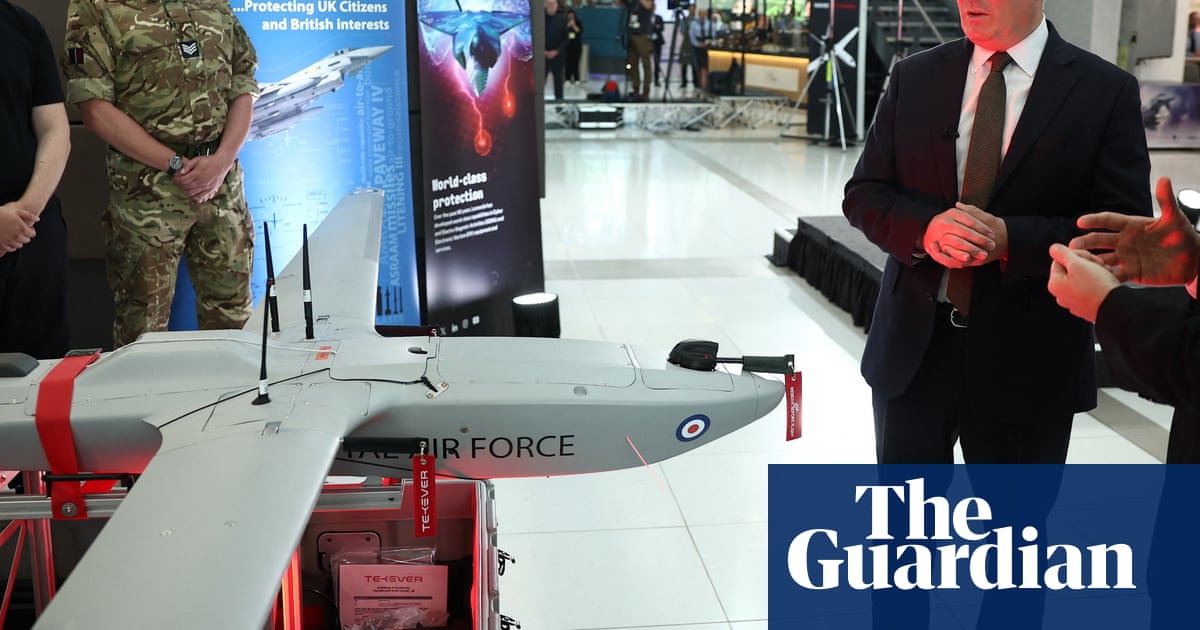Britain will spend an extra £2bn on drones and seek to introduce weapons and tactics developed during the war in Ukraine under a strategicdefence review unveiled by the government.
The plan will prioritise cheap one-way attack craft and more expensive reusable systems, as well as the creation of a drone centre to share knowledge and better coordinate across the armed forces.
John Healey, the defence secretary, told MPs the army would become “10 times more lethal” by combining technologies such as drones and artificial intelligence “with the heavy metal of tanks and artillery”.
It was part of a wider commitment to make the UK “battle-ready” in the words of the prime minister, Keir Starmer. He argued on a visit to the BAE Systems shipyard at Govan, in Glasgow, that defence had to come above other public services.
Drones have transformed the battlefield in Ukraine, with Moscow and Kyiv’s forces now making heavy use of attack and surveillance drones several miles beyond the frontline, causing an estimated 70% of casualties.
On Sunday, Ukraine launched coordinated attacks from remotely piloted drones hidden inside trucks aimed at airfields deep inside Russia. Kyiv claimed it had destroyed or damaged 41 Russian aircraft in the innovative long-range attack.
The strategic review said drones had become “an essential component of land warfare” and the army needed to invest in a mix of attack drones, surveillance craft and counter-drone technology.
But critics said remotely piloted drones risked increasing the chance of conflict. Chris Cole, of the research group Drone Wars UK, said that drones “lower the threshold for the use of armed force” and so could “encourage war as the firstrather than the last option”.
Starmer said the 140-page defence review was “a blueprint to make Britain safer and stronger, a battle-ready, armour-clad nation with the strongest alliances and the most advanced capabilities”.
The prime minister reiterated that the UK would spend 2.5% of GDP on defence by 2027, but declined to set a firm date on when that would increase to 3%. Labour has committed to a further increase during the next parliament.
The review concluded that Britain faced “multiple, direct threats” to its security for the first time since the end of the cold war – and that to deter conflict in the future the UK must be “ready to fight and win”.
But while the review team described the government’s 2.5% target as “good news”, it said a reversal of the hollowing-out of the armed forces would take about 10 years on current budget forecasts. “As we live in such turbulent times, it may be necessary to go faster,” the team said.
The target size of the British army will be increased from 73,000 to 76,000 in the next parliament as funding becomes available,Healeytold MPs. But he added that the immediate priority was to reverse falls in personnel numbers. Last week, the total number of soldiers had dropped to a low of 70,860.
The review also commits the UK to:
Explore the possibility of reintroducing air-launched nuclear weapons by discussing with the US and Nato the possibility of buying F-35A fighters equipped with US B61-12 bombs.
Spending £15bn to develop new submarine-launched nuclear warheads – and committing to build 12 nuclear-powered attack submarines in Derby and Barrow, starting in the 2030s.
Investing £1bn in air and missile defence, £6bn on munitions during this parliament and opening at least six weapons factories to increase military stockpiles, which currently may last only a few days in a crisis.
Developing a home guard, modelled on the army reserves, to ensure the protection of airports, communications sites and other parts of the critical national infrastructure in a major crisis.
On Monday, Starmer said he was not “as the prime minister of aLabourgovernment, going to make a commitment as to the precise date” as to when defence spending would increase to 3%. “I don’t believe in performative fantasy politics, and certainly not on defence and security,” the prime minister said.
That prompted the Conservatives to accuse Labour of underfunding the new plan. James Cartlidge, the shadow defence secretary, said the prime minister had been unable to set a date for the 3% target “because the Treasury haven’t approved a plan to pay for it”.
Starmer is due to join western leaders at a Nato summit this month. NATO members are expected to agree to a proposal from Mark Rutte, the alliance’s secretary general, that member states agree to spend 3.5% on defence by 2035 and a further 1.5% on cyber defences and other military-related infrastructure.
Donald Trump, the US president, has demanded that Nato members lift defence budgets to 5% of GDP while Washington has indicated it would reduce its focus on Europe. No American troops are expected to participate in a “reassurance force” designed to ensure peace in Ukraine if a long-term ceasefire is agreed.
